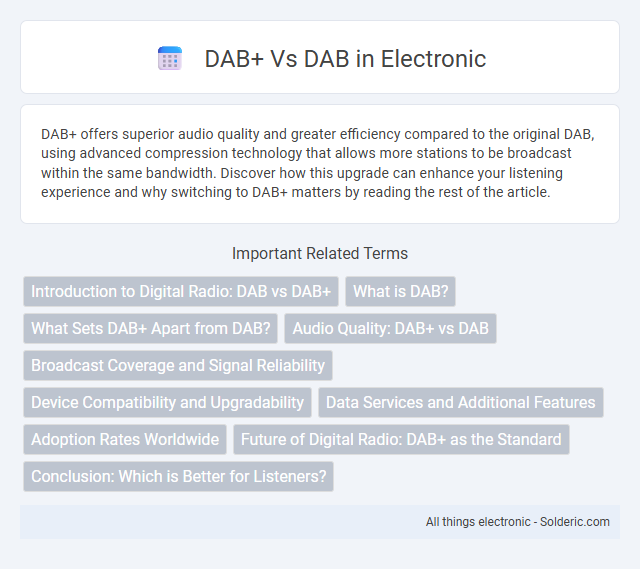DAB+ offers superior audio quality and greater efficiency compared to the original DAB, using advanced compression technology that allows more stations to be broadcast within the same bandwidth. Discover how this upgrade can enhance your listening experience and why switching to DAB+ matters by reading the rest of the article.
Comparison Table
| Feature | DAB | DAB+ |
|---|---|---|
| Audio Codec | MPEG-1 Audio Layer II (MP2) | HE-AAC v2 (more efficient) |
| Audio Quality | Good | Improved clarity with lower bitrates |
| Error Correction | Robust but less efficient | Enhanced error correction for better reception |
| Bandwidth Efficiency | Lower, higher bitrate required | Higher, supports more stations per frequency |
| Compatibility | Older receivers only | Requires compatible DAB+ receivers |
| Adoption | Phased out in many countries | Widely adopted globally |
Introduction to Digital Radio: DAB vs DAB+
DAB+ is an advanced version of DAB, utilizing a more efficient audio codec called HE-AAC v2, which delivers higher sound quality at lower bitrates, enhancing your digital radio experience. While both DAB and DAB+ operate on similar digital standards for broadcasting, DAB+ offers improved compression and error correction, leading to better signal reliability and more available channels. Choosing a DAB+ compatible device ensures compatibility with the latest digital radio broadcasts and access to a broader range of stations.
What is DAB?
DAB (Digital Audio Broadcasting) is a digital radio standard designed to provide higher sound quality and more efficient spectrum use compared to traditional analog FM radio. It transmits audio digitally, allowing for multiple radio channels to be broadcast over a single frequency block, reducing interference and improving reception consistency. DAB+ is an enhanced version that uses the more efficient AAC+ codec, offering better audio quality and more stations within the same bandwidth.
What Sets DAB+ Apart from DAB?
DAB+ advances digital radio technology by employing the more efficient HE-AAC codec for audio compression, resulting in better sound quality and increased channel capacity compared to the original DAB system, which uses the less efficient MPEG-1 Audio Layer II codec. The improved error correction in DAB+ enhances signal robustness and reduces audio dropouts, especially in mobile and fringe reception areas. These technical enhancements allow broadcasters to deliver more stations and diverse content within the same frequency spectrum, making DAB+ a superior digital radio standard.
Audio Quality: DAB+ vs DAB
DAB+ offers significantly improved audio quality compared to DAB by using the more efficient HE-AAC codec, resulting in clearer sound and better compression. This codec allows broadcasters to transmit higher fidelity audio at lower bitrates, enhancing your listening experience without increasing bandwidth usage. Listeners generally notice richer, more detailed audio on DAB+ stations compared to traditional DAB broadcasts.
Broadcast Coverage and Signal Reliability
DAB+ offers improved broadcast coverage compared to DAB, utilizing more efficient audio compression (HE-AAC) that enables broadcasters to transmit higher quality signals within the same bandwidth. This efficiency allows for extended coverage areas and reduced signal interference, enhancing overall signal reliability in challenging environments such as urban settings or regions with varied topography. Consequently, DAB+ provides listeners with more consistent reception and fewer dropouts, making it the preferred standard for modern digital radio broadcasting.
Device Compatibility and Upgradability
DAB+ offers enhanced device compatibility compared to the original DAB by supporting a wider range of digital radios and multimedia devices due to its advanced AAC+ audio codec. Many existing DAB radios can be upgraded to DAB+ through firmware updates, enabling users to access improved audio quality and additional channels without replacing hardware. This upgradability ensures seamless integration with newer broadcasting standards while preserving investment in older devices.
Data Services and Additional Features
DAB+ offers enhanced data services compared to DAB by supporting faster and more efficient audio codecs that allow added functionalities such as multimedia content, text information, and program guides. The improved error correction in DAB+ ensures clearer reception of text-based features like song titles, weather updates, and news alerts, enriching your listening experience. This expanded capability makes DAB+ a superior choice for accessing advanced digital radio features beyond traditional audio broadcasts.
Adoption Rates Worldwide
DAB+ has seen faster global adoption compared to DAB, with countries like Norway and Australia leading in nationwide coverage and digital radio listening. The advanced audio codec in DAB+ allows for better sound quality and more efficient spectrum use, driving broadcasters to upgrade. Your access to diverse digital radio content improves as more regions transition from DAB to the more widely supported DAB+ standard.
Future of Digital Radio: DAB+ as the Standard
DAB+ offers enhanced audio quality and greater spectrum efficiency compared to the original DAB, making it the preferred choice for the future of digital radio broadcasting. It supports more stations within the same bandwidth by using the superior HE-AAC codec, improving listener experience and broadcaster capacity. Many countries are transitioning to DAB+ as the standard to ensure sustainable growth and technological advancement in digital radio services.
Conclusion: Which is Better for Listeners?
DAB+ offers superior audio quality and more efficient spectrum usage compared to DAB, making it the preferred choice for listeners seeking clearer sound and a wider selection of stations. You benefit from enhanced error correction and lower transmission costs, enabling broadcasters to provide more diverse and reliable content. Overall, DAB+ outperforms DAB in delivering a better listening experience and future-proof digital radio technology.
DAB+ vs DAB Infographic

 solderic.com
solderic.com